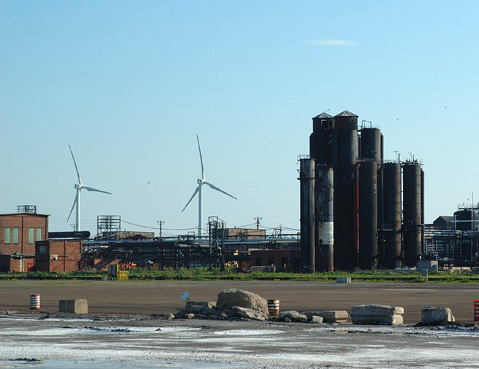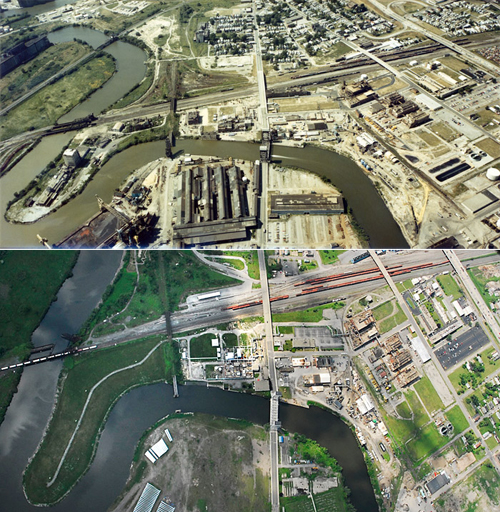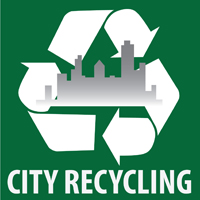
South of Buffalo, wind turbines stand on the redeveloped former site of Bethlehem Steel in Lakawanna, N.Y. Photo: First Winds
Editors note: This is part of a series of stories about innovative ways of recycling abandoned urban land in the Great Lakes region.
By Liz Pacheco
BUFFALO – The shores of Lake Erie here are scarred with remnants of another time. Crumbling buildings, abandoned warehouses and rusting equipment are reminders of when industry fueled the city. But amidst the eyesores is evidence of Buffalo’s exciting future.
On the former site of Bethlehem Steel stand eight wind turbines.
Their steel blades swing in a calming rhythm, effortlessly cutting through the gloom left haunting the abandoned industry. In Buffalo, the past is fueling a future of innovation, turning the Rust Belt into the Wind Belt.
The turbines hint at a broader redevelopment driven by diverse motivations. Local officials are using the past to prepare for the future and revive a city from economic shock.
“We use the land for 125 years and then in a span of 20 years [the industry] all left,” said Marty Doster, regional engineer for hazardous waste remediation with the New York State Department of Environmental Conservation. “The task of this generation of people is to transition from what was a heavy industry past to the future. It’s for us to decide what that future has to be.”
From steel to wind

Photo: First Winds
Located in Lakawanna, NY, just a few miles south of Buffalo, the former Bethlehem Steel site is now known as Steel Winds. The project was finished in 2007 with plans for an additional 10 turbines. Together, the turbines can generate more than 50 million kilowatts of energy annually. That’s enough to power about 9,000 New York homes.
But Steel Winds is more than a source of alternative energy. The project has brought pride to the community. “Like every small city, we don’t like change,” said Doster, who works directly with cleaning these brownfield sites. Seeing the turbines, “people get proud and think they must be on the cutting edge of technology.” Changing citizen perceptions about their city is a challenging part of brownfield cleanup and redevelopment in Buffalo, he said.
At its height, the steel mill employed more than 20,000 people. When it closed in 1970, around the time most steel industries failed in Buffalo, Lackawanna’s population and economy took a serious hit. The state has designated Lackawanna a New York Empire Zone. Such zones are considered economically distressed and provide tax incentives to stimulate economic and job growth.
The 30-acre steel site sat untouched for 30 years before EPA gave Lackawanna a $200,000 grant to evaluate numerous contaminated areas, including the mill. After the assessment, private developer First Wind and electric utility BQ Energy purchased the land and funded the redevelopment. While some remediation was done, building wind turbines on the site meant that extensive cleanup wasn’t necessary.
BQ Energy now runs the turbines and benefits from the state’s brownfield tax incentives legislation. If a developer comes in through the state’s Brownfield Cleanup Program and does a cleanup to satisfaction, they can get significant tax credits both on the cleanup and new buildings, explained Doster. This is what happened at Steel Winds. Instead of property taxes, the energy company pays Lackawanna $100,000 a year for the next 15 years.
Without the incentive the site might still be unoccupied. These abandoned industrial sites, typically left by bankrupt companies, are very difficult for cities to handle.
“If it’s a residential property the city can easily foreclose on the property and take ownership,” said Dave Stebbins, vice president of Buffalo Urban Development Corp. “They don’t like to do that for industrial properties because there’s a huge liability that they don’t want to be stuck with. So, these properties end up in limbo.” No owner means no taxes are being paid and cities don’t like to eliminate that revenue, said Stebbins.
A home for history

The remediated Buffalo Color site along the Buffalo River (top, 1980; bottom, 2009) will host museums. Photos: South Buffalo Development Corp. Click to enlarge.
Another Buffalo brownfield project restores the city’s history. The Buffalo Color site was home to the first commercial producer of dyes in the U.S., now known as Allied Chemicals. The site has seen multiple owners. The last, the Buffalo Color Corp., declared bankruptcy in 2003.
The site covers 70 acres adjacent to the Buffalo River and the railroad system. Many original buildings and production machines of the dye company remain. That made the site particularly interesting to the Western New York Railway society, explained Dave Flynn, a lawyer who specializes in environmental cleanup, brownfields and renewable energy in New York.
The railway society plans to open Heritage DiscoveRY Center on the property along with the Steel Plant Museum. For 30 years the railway society had searched for a home for their museum.
Railroads are an intrinsic aspect of Buffalo. “The railroads basically carved up the land as we see it today. They were a huge player,” said Doster. “You have your railroad, you have your heavy industry. That’s why Buffalo made was the eighth largest city in the country at one time.”
The site is being remediated as part of New York’s Brownfield Cleanup Program. The first phase won’t be completed until early 2011 and it could take up to another year before the other two phases are finished. Building demolition, remedial design and asbestos cleanup are part of the first phase. Soil and groundwater remediation will be done in the second phase.
An urban heart transplant
Innovation is inspiring brownfield restoration in Buffalo. Steel Winds creates energy for the future and the Buffalo Color Corp. revives the community’s railway history. And now, the Buffalo River Restoration project is using brownfield restoration as an urban heart transplant.
By the 1900s major car, steel and chemical industries had come to Buffalo. “The majority of that manufacturing took place in the southern part of Buffalo, right near the Buffalo River and south of that,” said Doster.
The Buffalo River drove the city’s industrial heritage, explained Jill Spisiak-Jedlica, coordinator of the restoration project with Buffalo Niagara Riverkeeper. In the 1800s the river was dredged for the Erie Canal. Since then, the river channel has been dredged many times and the channel shifted. The river is essentially artificially maintained, said Spisiak-Jedlica.
With the river’s expansion came shipping lanes, lake freighters and grain elevators. The river became a place to dispose wastewater. It is “an underwater brownfield,” said Spisiak-Jedlica.
Buffalo is doing a $40 million river cleanup to restore the heart of the city. “[The Buffalo River] goes through the heart of downtown and weaves it way into the industrial belt which has all the region’s steel and chemical manufacturing and left behind vast acreages of property,” said Doster.
The project’s remediation begins this spring with dredging to clear contaminated sediment from the river’s navigation channel. The U.S. Army Corps of Engineers, which is responsible for maintaining this channel, will handle the dredging. The second phase addresses contaminated sediments outside that channel and will be overseen by the EPA. There are also proposals to restore natural habitat along the river.
While federal organizations will direct the large-scale remediation, Buffalo Niagara Riverkeeper has been a key player in the project’s success. The non-profit organization, which works to protect water resources in the Buffalo Niagara region, is familiar with the river and with the communities involved. Spisiak-Jedlica sits on the steering committee for the larger South Buffalo Brownfield Opportunity Area, which encompasses the river. The South Buffalo project is 1,600 acres, the largest brownfield project in New York.
Riverkeeper’s involvement has also been critical in gaining community input both on the Buffalo River and larger South Buffalo projects.
“People are so interested in the future,” said Spisiak-Jedlica. “They see wide open spaces and can envision a future for Buffalo.”
But everyone’s view of the future is not the same and Riverkeeper mediates conflicts. Some see cleaned brownfield sites as perfect places for golf courses, others want 300-acre nature preserves, said Spisiak-Jedlica. “There are competing interests and we’re not going to please everyone.”
Solving Buffalo’s brownfield challenges with creativity
Despite all the great projects happening in Buffalo, cleaning and redeveloping brownfield sites isn’t easy.
“We don’t have an economic engine that will drive this [redevelopment] naturally,” said Doster. He cited New York City and Pittsburgh as two places where economic activity within the cities drives the redevelopment. Buffalo relies mostly on federal initiatives to start brownfield cleanup so redevelopment can happen.
“We have so much brownfields here it’s just essential that we bring inventory of land online here,” said Peter Cammarata, president of Buffalo Urban Development Corp.
“One of the dilemmas in the city is that if someone wanted to come in and purchase 100 acres to build, [Buffalo] didn’t have that land to sell,” said Doster. Industry bankruptcies and individual owners of properties left this land inaccessible for developers.
Thanks to work by Doster, Stebbins and Cammarata with support from federal and state funds there are now large remediated brownfield areas being developed and available for purchase.
The size of these brownfield areas has become distinctive to Buffalo.
“They have much larger sites than we do, in Rochester,” said Mark Gregor, manager of the Environmental Quality Division at Rochester, NY and works on brownfield remediation and redevelopment for the city. “Our average or typical site is a half acre to four-five acres. In Buffalo it’s not unusual to have 100 acres.”
While Rochester does have an industrial history and a population size comparable to Buffalo, Gregor describes Buffalo as having a much larger industrial setting and geographic area.
Buffalo is unique for other reasons too, he said.
“We sit on a Great Lake and…we have an opportunity to recreate a waterfront for our use…We have a good partnership between the city, the county, the state and not-for-profits, like Riverkeeper.
“It’s a fun time to be in this business, to pull together and try to recreate the plate for the next generation.”
More from this series:
- Great Lakes cities recycle brownfields into economic hope
-
Solar power transforms a Chicago brownfield into a shining brightfield
-
Community support, diverse funds save historic building from demolition
-
Officials hope former truck factory helps make Michigan a movie star
- Federal loan brings employment hope to Wisconsin brownfields
- Detroit businessman proposes large scale commercial farm to struggling city

Hey, two of my favorite things meet, Buffalo and Michigan State Journalism! I like it! Fantastic work here. Even as a Buffalo native I had missed the news about the Buffalo Color project…